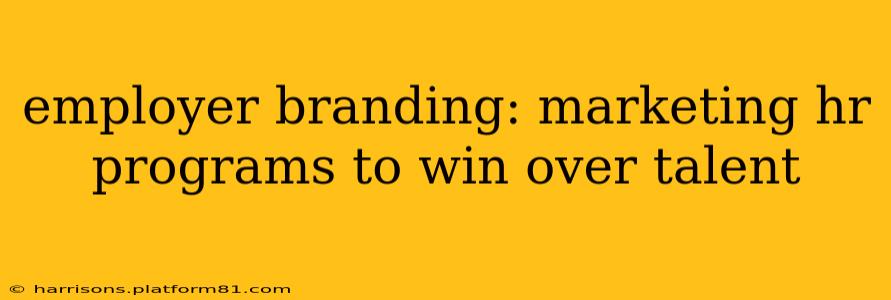In today's competitive job market, attracting and retaining top talent is crucial for business success. Employer branding is no longer a "nice-to-have"—it's a necessity. It's about showcasing your company culture, values, and employee experience to potential hires, transforming your organization from just another job listing into a desirable destination. This means marketing your HR programs effectively to win over the hearts and minds of the best candidates. This isn't just about posting job openings; it's about crafting a compelling narrative that resonates with your target audience.
What is Employer Branding?
Employer branding is the strategic process of building a reputation as a great place to work. It goes beyond simply advertising open positions. It involves crafting a consistent and compelling message about your company culture, values, employee benefits, and overall employee experience. The goal is to attract top talent, improve employee retention, and strengthen your company's reputation.
A strong employer brand differentiates you from competitors, making your company more appealing to potential hires who align with your mission and values. It’s about showcasing what makes your workplace unique and desirable, such as opportunities for growth, a positive work environment, and a commitment to employee well-being.
How to Market HR Programs to Attract Top Talent
Marketing your HR programs effectively requires a multi-faceted approach:
1. Define Your Employer Value Proposition (EVP)
Before you start marketing, you need a clear understanding of your EVP. What makes your company a great place to work? What unique benefits and opportunities do you offer that competitors don't? Your EVP should be authentic, based on real employee experiences, and easily communicated. This forms the foundation of your employer branding strategy.
2. Showcase Your Company Culture
Your company culture is a significant factor in attracting talent. Highlight aspects of your workplace culture that are positive and appealing. This can be done through various channels:
- Social Media: Share photos and videos showcasing employee events, team activities, and the overall work environment.
- Employee Testimonials: Feature stories and testimonials from current employees about their positive experiences working at your company.
- Company Blog: Write articles about your company culture, values, and employee initiatives.
- Career Page: Dedicate a section on your career page specifically to showcase your company culture.
3. Highlight Your HR Programs and Benefits
Your HR programs are a key selling point. Make sure to effectively communicate the value of your employee benefits, including:
- Compensation and Benefits: Be transparent about your salary ranges and benefits packages.
- Learning and Development Opportunities: Highlight opportunities for professional growth and development.
- Wellness Programs: Showcase your commitment to employee well-being through wellness initiatives.
- Flexible Work Arrangements: If you offer flexible work options, make sure to promote them.
- Employee Recognition Programs: Highlight programs that recognize and reward employee contributions.
4. Utilize Different Marketing Channels
To reach a wider audience, employ a diverse range of marketing channels:
- Social Media Marketing: Engage potential candidates on platforms like LinkedIn, Instagram, and Twitter.
- Content Marketing: Create valuable content, such as blog posts, articles, and videos, related to your industry and company culture.
- Search Engine Optimization (SEO): Optimize your career page and other online content for relevant keywords to improve your search engine ranking.
- Employee Referral Programs: Encourage current employees to refer their friends and family.
- Campus Recruiting: Partner with universities and colleges to recruit recent graduates.
5. Measure and Adapt Your Strategy
Track the success of your employer branding efforts by measuring key metrics such as application rates, time-to-hire, and employee retention. Use these metrics to adapt and refine your strategy over time.
Frequently Asked Questions (FAQs)
How can I make my employer branding more authentic?
Authenticity is key. Avoid using clichés and focus on showcasing the genuine aspects of your company culture and employee experiences. Let your employees' voices be heard through testimonials and stories. Highlight your company's unique strengths and values.
What is the role of employee advocacy in employer branding?
Employee advocacy is crucial. Empowered employees who are passionate about their work act as brand ambassadors, sharing positive experiences and attracting potential candidates organically. Encourage employees to share their experiences on social media and through word-of-mouth referrals.
How can I measure the success of my employer branding efforts?
Measure key metrics such as application rates, time-to-hire, cost-per-hire, employee retention rates, and employee Net Promoter Score (eNPS). Analyze website traffic to your career page and social media engagement to gauge the effectiveness of your strategies. Regularly evaluate your metrics and adapt your approach based on the data.
What is the difference between employer branding and recruitment marketing?
While closely related, employer branding and recruitment marketing are distinct. Employer branding focuses on building a long-term reputation as a great place to work, attracting top talent over time. Recruitment marketing focuses on attracting candidates for specific job openings using targeted strategies and campaigns. Think of employer branding as the foundation, and recruitment marketing as the specific tactics employed to attract candidates for particular roles.
By implementing a comprehensive employer branding strategy and effectively marketing your HR programs, you can attract and retain the top talent your organization needs to thrive in today’s competitive landscape. Remember, it's a long-term investment that yields substantial returns in the form of a more engaged, productive, and loyal workforce.
